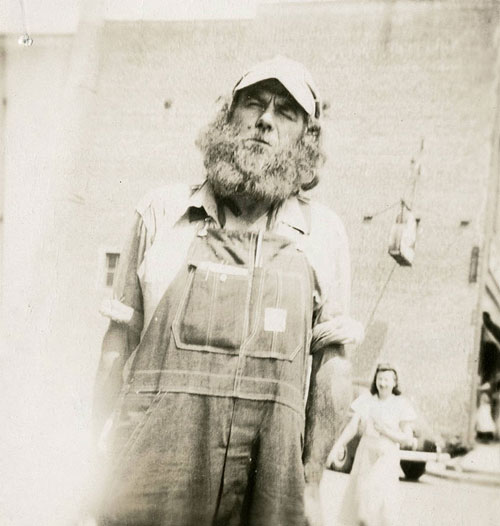I was searching for some information on the Remember Cliffside website several days ago when I stumbled upon a story about the Goat Man. Reno Bailey, the creator of Remember Cliffside, recalls from childhood a man who used to pass through town with a wagon pulled by goats and made money by taking photographs of children posed in his wagon. Bailey described how his young imagination had added a few details to the Goat Man’s biography. In his mind, the itinerant goatherd was a Nazi spy taking photographs of the town’s power plant and other installations. Of course, as an adult, Bailey learned that the Goat Man was not a spy. Instead he was a man who traveled the South’s backroads with his goats and, occasionally, some two-legged companions, preaching and living off the land and the kindness of strangers.
I probably wouldn’t have given the story much more thought if I hadn’t come across these two images of the Goat Man in the North Carolina Postcards online collection yesterday.
I figured if there were postcards of the Goat Man and if he drew such large crowds when he preached, then someone must have written about him. Heck, I thought, maybe there’s even a Wikipedia page about him. Indeed, there is. There’s also a book and a song about the Goat Man, whose real name was Charles “Ches” McCartney.
According to several biographies on the web, including one in the New Georgia Encyclopedia, McCartney was born on an Iowa farm in 1901. At 14 he left home and headed for New York City. There he met and, eventually, married a Spanish woman who had a knife throwing act. McCartney, who was allegedly 10 years his wife’s junior, served as her knife throwing target. When the couple had a son, they left the city and began a life of farming. The Depression hit the couple hard and McCartney searched for other work. In 1935 McCartney was injured while cutting timber as part of a Works Progress Administration project. Some accounts suggest that a tree fell on him and several hours elapsed before he was found. According to those stories, McCartney was pronounced dead and taken to a mortuary. As the undertaker inserted a needle with embalming fluid into his arm, McCartney stirred.
Whether because of this supposed near death experience or for other reasons, McCartney underwent a religious reawakening. He hitched up a wagon to a team of goats and, accompanied by his wife and son, he took to the road preaching. Wearing goatskin clothes fashioned by his wife, McCartney called for sinners to repent or face eternal damnation. He marked his path with signs bearing such messages as “Prepare to Meet Thy God,” with the fires of hell painted at the bottom. Eventually McCartney’s wife tired of the itinerant life and she left, taking their son with her. McCartney continued his travels, inspired, he said, by Daniel Defoe’s Robinson Crusoe and the Bible, two books he carried with him. Along the way, McCartney married two more times and may have fathered several more children. At some point his son, Albert Gene, joined him on the road.

McCartney established a base in Twiggs County, Georgia, calling his home the Free Thinking Christian Mission. From there, he continued his travels, claiming to visited all of the lower 48 states as well as Alaska and Canada during almost 50 years on the road. Although he eventually forsook goatskin clothing for denim overalls, his fiery sermons and eccentric appearance left strong impressions on those whom he encountered. Flannery O’Connor mentioned the Goat Man in letters and may have incorporated some of his ways into her characters. It is believed that Cormac McCarthy’s novel Suttree includes a character based on McCartney.
McCartney retired from the road in the late 60s or early 70s, shortly after a mugging during which three of his ribs were broken and two goats killed. When his mission building burned in 1978, McCartney and his son moved into a broken down school bus. He made one last road journey in 1985 when he set out on foot toward Los Angeles in hopes of meeting and marrying the actress Morgan Fairchild. After a mugging on that trip, he returned to Georgia and lived in a nursing home until his death at the age of 97 in 1998.
If you met the Goat Man along the way, please share your memories with us.


